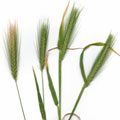Dr. Perricone's No. 6 Superfood: Barley Grass, Wheatgrass and Other Green Foods

Plant Power in Small Packages
When we talk about "green foods," we're referring to a group of foods that includes young cereal grasses like barley grass and wheatgrass, as well a blue-green algae known as BGA. Nutritionally, they are close cousins to dark green leafy vegetables, but offer far greater levels of "nutrient density." In other words, an ounce of these concentrated green foods contains much more of the beneficial phytonutrients found in an ounce of green vegetables.
The results of many experimental studies show that green foods have marked beneficial effects on cholesterol, blood pressure, immune response and cancer prevention. These effects are attributed in part to their high concentrations of chlorophyll.
Chlorophyll, the phytochemical that gives leaves, plants and algae their green hues, is the plant equivalent of the oxygen-carrying red pigment hemoglobin in red blood cells. Dietary chlorophyll inhibits disease bacteria and exerts therapeutic effects on bad breath and internal odors.
Wheat and Barley Grasses
Young cereal grasses—especially wheat and barley grass—are distinguished by their brilliant emerald green hues. Before World War II, drug stores throughout the country, but especially in the grain-belt states of the Midwest, sold tablets of dried wheat or barley grass as a kind of primitive vitamin supplement. Today, young wheat and barley grasses are dried and powdered to make dietary supplements, or picked fresh to process in juicing machines.
At the early grass stage of their growth, wheat and barley are closer to vegetables than grains in composition. This is important to note because while I strongly discourage eating wheat and wheat products, I believe wheatgrass is an excellent addition to your diet.
The nutrient profiles of green cereal plants change quickly as they grow. As the plant grows, the chlorophyll, protein and vitamin content of cereal grasses declines sharply and the level of cellulose (indigestible fiber) increases. Over a period of several months, the green leafy cereal grasses become amber waves of grain bearing the kernels we harvest to make into flour—an unhealthy, pro-inflammatory food.
There is very little nutritional difference between wheat grass and barley grass, although it is important to note that barley grass acts as a free radical scavenger that also reduces inflammation and pain, and wheat grass contains P4D1, a "gluco-protein" that acts like an antioxidant, reducing inflammation. It is also thought to be able to help the body attack cancer cells.
You can get cereal grasses in powder or tablet form. Dried cereal grasses are certainly easier to handle than fresh, which must be juiced. However, fresh grass juice contains healthful enzymes not found in dried grass powder and is likely to be higher in just about every phytonutrient found in cereal grass. Many juice bars and health-oriented markets offer these juices on their menus.
Learn More About Dr. Perricone's Superfoods:
When we talk about "green foods," we're referring to a group of foods that includes young cereal grasses like barley grass and wheatgrass, as well a blue-green algae known as BGA. Nutritionally, they are close cousins to dark green leafy vegetables, but offer far greater levels of "nutrient density." In other words, an ounce of these concentrated green foods contains much more of the beneficial phytonutrients found in an ounce of green vegetables.
The results of many experimental studies show that green foods have marked beneficial effects on cholesterol, blood pressure, immune response and cancer prevention. These effects are attributed in part to their high concentrations of chlorophyll.
Chlorophyll, the phytochemical that gives leaves, plants and algae their green hues, is the plant equivalent of the oxygen-carrying red pigment hemoglobin in red blood cells. Dietary chlorophyll inhibits disease bacteria and exerts therapeutic effects on bad breath and internal odors.
Wheat and Barley Grasses
Young cereal grasses—especially wheat and barley grass—are distinguished by their brilliant emerald green hues. Before World War II, drug stores throughout the country, but especially in the grain-belt states of the Midwest, sold tablets of dried wheat or barley grass as a kind of primitive vitamin supplement. Today, young wheat and barley grasses are dried and powdered to make dietary supplements, or picked fresh to process in juicing machines.
At the early grass stage of their growth, wheat and barley are closer to vegetables than grains in composition. This is important to note because while I strongly discourage eating wheat and wheat products, I believe wheatgrass is an excellent addition to your diet.
The nutrient profiles of green cereal plants change quickly as they grow. As the plant grows, the chlorophyll, protein and vitamin content of cereal grasses declines sharply and the level of cellulose (indigestible fiber) increases. Over a period of several months, the green leafy cereal grasses become amber waves of grain bearing the kernels we harvest to make into flour—an unhealthy, pro-inflammatory food.
There is very little nutritional difference between wheat grass and barley grass, although it is important to note that barley grass acts as a free radical scavenger that also reduces inflammation and pain, and wheat grass contains P4D1, a "gluco-protein" that acts like an antioxidant, reducing inflammation. It is also thought to be able to help the body attack cancer cells.
You can get cereal grasses in powder or tablet form. Dried cereal grasses are certainly easier to handle than fresh, which must be juiced. However, fresh grass juice contains healthful enzymes not found in dried grass powder and is likely to be higher in just about every phytonutrient found in cereal grass. Many juice bars and health-oriented markets offer these juices on their menus.
Learn More About Dr. Perricone's Superfoods:
As a reminder, always consult your doctor for medical advice and treatment before starting any program.



